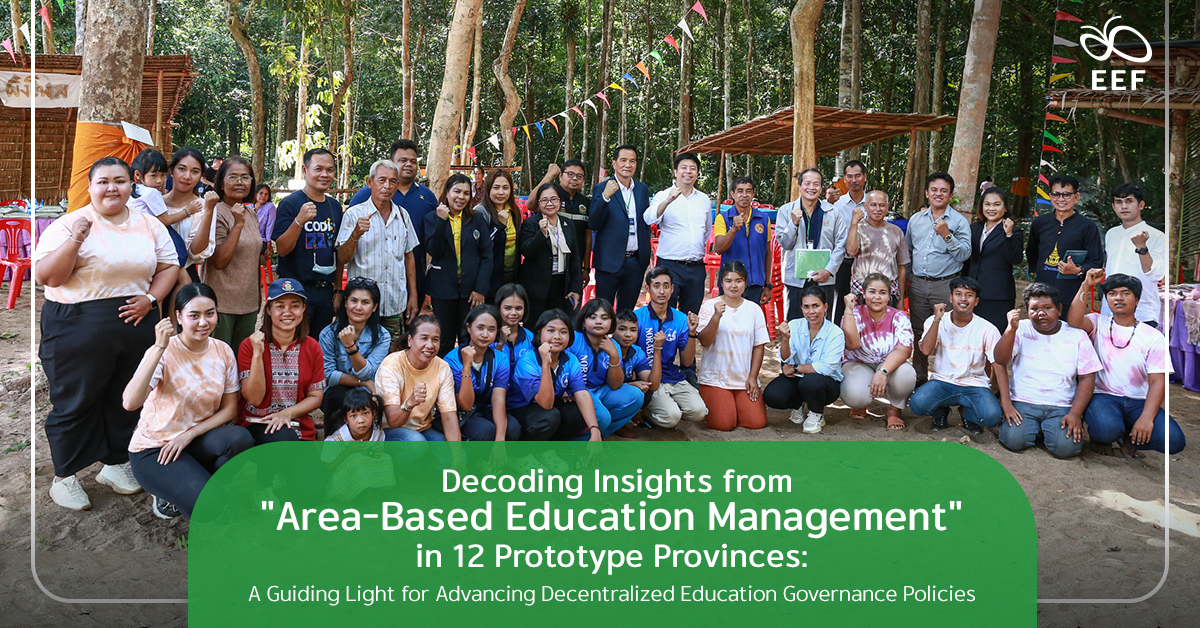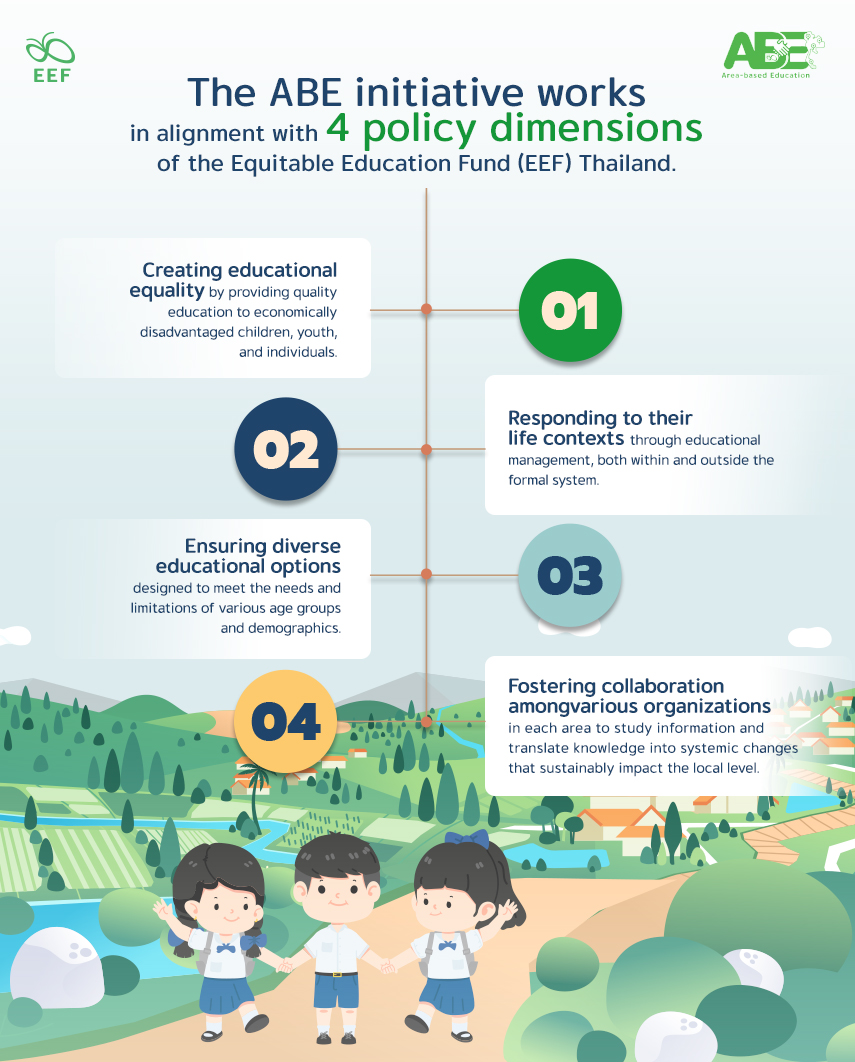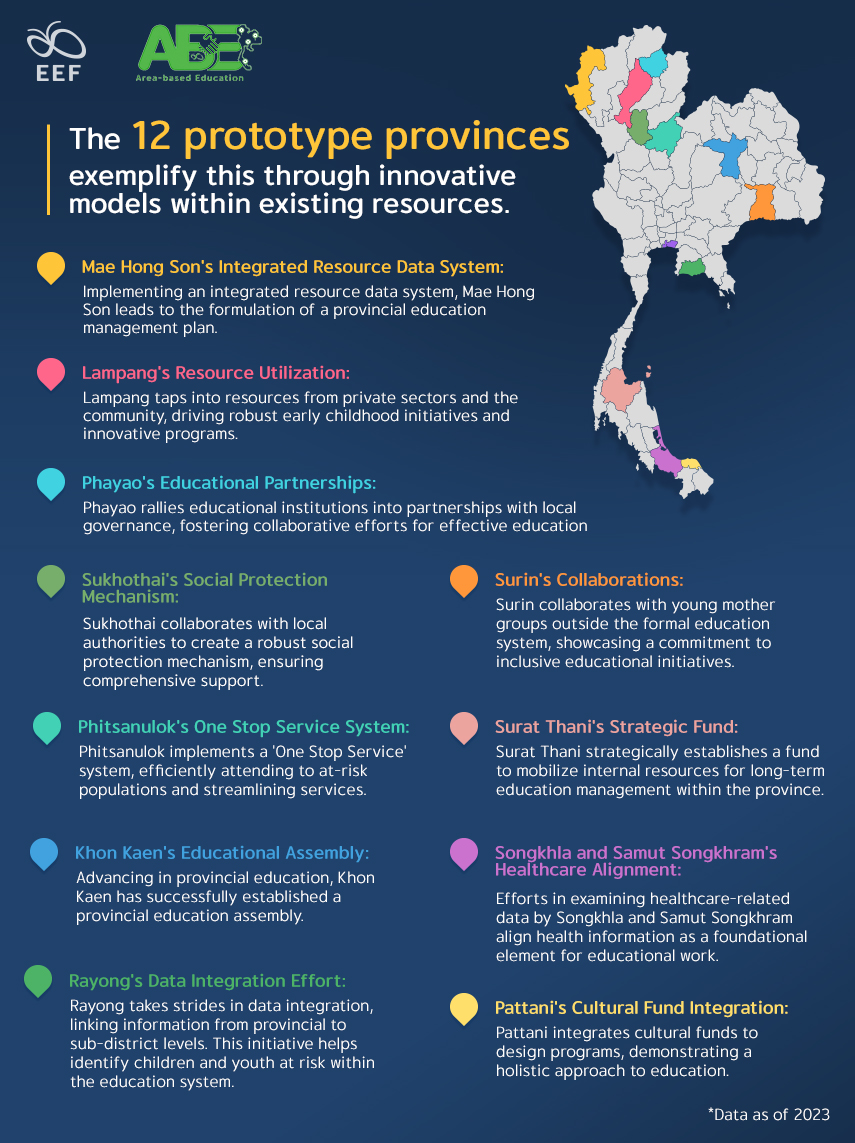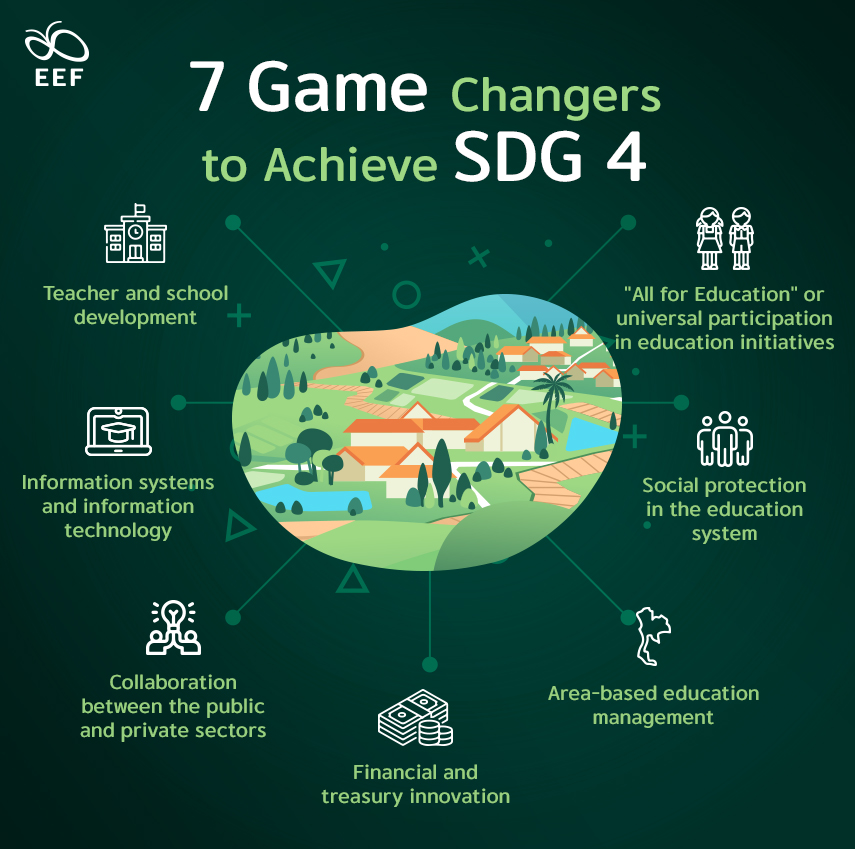
In the dynamic quest to rectify educational disparities in Thailand, the transformative “Area-Based Education” (ABE) initiative unfolds with groundbreaking significance, employing a simple, yet potent strategy— breaking down educational disparities into manageable local units through decentralized management. Its fundamental aim is to forge pathways to equal opportunities while deftly navigating local complexities, offering a compelling solution to educational inequalities. With a specific focus on economically disadvantaged children and youth, the project champions uniform educational opportunities, laying the cornerstone for a more just and equitable future. Collaborative mechanisms come to life at the district and provincial levels, all interconnected into a tapestry of cooperative networks poised to drive regional development.
In the “Decentralizing Education Management: Addressing Regional-Level Inequality” forum, insights meticulously gleaned from 12 prototype provinces are interwoven with precision. This amalgamation serves not only to amplify outcomes but also as a transformative catalyst for policy shifts in educational decentralization — a promising frontier, grounded in a nuanced understanding of regional working groups as indispensable “insiders.” This approach fosters a systematic analysis of issues that gives birth to a foundational support system crucial for transformative change.

With this acknowledgment, a network of provincial-level mechanisms has been established, seamlessly interconnecting sub-mechanisms in smaller areas, giving rise to “data systems” that refine decision-making. The focus has now sharpened on an expansive view of problem scenarios and tailored solutions, each resonating directly with the educational journey of children and youth. This pivotal revelation has redirected attention towards heightening community awareness of educational disparities, thereby opening up space for diverse voices in collaborative problem-solving. Thus, the stage has been set for a model of “harmonization” among organizations, orchestrating impartial collaboration — termed as “dots” within the ABE’s framework.
In the ABE’s construct, “dots,” or knowledge stations, have been strategically deployed, each representing various units intricately forming an educational management ecosystem, harboring the potential to alleviate disparities. Interconnecting these “dots,” amplifying each one’s success, and fortifying their impact until their collective contribution becomes unmistakable — this intricate process ensures heightened opportunities and expanded choices in education and learning for children and youth. Collectively, these elements depict a transformative journey towards a more equitable and enlightened educational future.
At the core of propelling the ABE initiative forward is the decentralization of authorities to local areas. This pivotal principle hinges on dual freedoms: the freedom to shape approaches and strategies tailored to the unique context of each area, and the freedom to devise solutions for diverse problems, considering the potential and circumstances at play. These tailored approaches are intricately connected to resource utilization, allowing for a prioritized allocation of resources.

The ABE initiative works in alignment with four policy dimensions of the Equitable Education Fund (EEF) Thailand. These dimensions include 1) creating educational equality by providing quality education to economically disadvantaged children, youth, and individuals; 2) responding to their life contexts through educational management, both within and outside the formal system; 3) ensuring diverse educational options designed to meet the needs and limitations of various age groups and demographics; and 4) fostering collaboration among various organizations in each area to study information and translate knowledge into systemic changes that sustainably impact the local level.
The harmonization of these four dimensions holds the power to eliminate the necessity for specific organizations solely dedicated to all of them in every province or area. Instead, collaborative efforts among the people within each province will uncover tools and work processes, culminating in the establishment of a central mechanism capable of receiving information and reporting internal situations. This collaborative mechanism empowers each province to independently steer its own education process, fueled by the freedoms derived from collective collaboration.

The 12 prototype provinces exemplify this through innovative models within existing resources. Examples include:
- Khon Kaen’s Educational Assembly: Advancing in provincial education, Khon Kaen has successfully established a provincial education assembly.
- Sukhothai’s Social Protection Mechanism: Sukhothai collaborates with local authorities to create a robust social protection mechanism, ensuring comprehensive support.
- Phayao’s Educational Partnerships: Phayao rallies educational institutions into partnerships with local governance, fostering collaborative efforts for effective education management.
- Rayong’s Data Integration Effort: Rayong takes strides in data integration, linking information from provincial to sub-district levels. This initiative helps identify children and youth at risk within the education system.
- Songkhla and Samut Songkhram’s Healthcare Alignment: Efforts in examining healthcare-related data by Songkhla and Samut Songkhram align health information as a foundational element for educational work.
Another crucial facet of area-based education management involves the creation of “collaborative integration plans” to consolidate various resources within the region for joint efforts. Examples include:
- Mae Hong Son’s Integrated Resource Data System: Implementing an integrated resource data system, Mae Hong Son leads to the formulation of a provincial education management plan.
- Lampang’s Resource Utilization: Lampang taps into resources from private sectors and the community, driving robust early childhood initiatives and innovative programs.
- Surat Thani’s Strategic Fund: Surat Thani strategically establishes a fund to mobilize internal resources for long-term education management within the province.
- Phitsanulok’s One Stop Service System: Phitsanulok implements a ‘One Stop Service’ system, efficiently attending to at-risk populations and streamlining services.
- Surin’s Collaborations: Surin collaborates with young mother groups outside the formal education system, showcasing a commitment to inclusive educational initiatives.
- Pattani’s Cultural Fund Integration: Pattani integrates cultural funds to design programs, demonstrating a holistic approach to education.
All these instances exemplify the ideals of an area-based education management mechanism in action, showcasing innovative models and goal-specific care initiatives within the constraints of existing resources. The management and improvement of educational quality require substantial budgetary support and resources. However, another crucial aspect is the readiness of the driving mechanism within each area. The provinces or areas must recognize their own challenges and be prepared to address the gaps that central authorities may need to be aware of.
The initiatives of the 12 prototype provinces illustrate the preparedness for decentralization of educational management authority. These efforts need to progress toward policy-driven actions, attempting to make the pioneering areas exemplary successes. This communicates to the policymakers that the decentralization of educational management, driven by collaboration and participation from within a province or an area, has led to educational innovations and knowledge suitable for specific localities. This has the potential to transform the lives of the country’s most disadvantaged population or bottom 15%.
Presenting significant discoveries and perspectives from the pioneering areas is crucial. These approaches will serve as models for Thailand’s future education, moving away from a single-track school-centric system. Instead, the management of education today and for the future must offer diverse options to meet the development needs of everyone, supporting individual growth based on interests and aptitudes.

The success of the ABE initiative, which falls under SDG4, can catalyze progress in other goals, such as poverty eradication, reducing inequality, sustainable communities, and global partnerships. To achieve SDG 4, seven Game Changers have been outlined: 1) Teacher and school development; 2) Information systems and information technology; 3) Collaboration between the public and private sectors; 4) Financial and treasury innovation; 5) Area-based education management; 6) Social protection in the education system; and 7) “All for Education” or universal participation in education initiatives
However, the COVID-19 pandemic posed challenges, exacerbating educational inequalities, particularly for online learners facing developmental setbacks. To address this, the Bangkok Statement 2022 emerged, focusing on effective learning recovery and educational transformation in the Asia-Pacific region. Managing education within each locality is of utmost urgency to truly tackle the intricate issue of educational disparities. Establishing “Learning Cities” is essential, serving as the key to achieving all 17 SDGs. In the last seven years leading up to 2030, educational strategies must be contextualized to address the unique challenges in each area.

The Area-based Education (ABE) framework takes on a winding and iterative path, orchestrating cycles to induce systemic changes from local to national levels. Operationalizing ABE involves provincial-level data collection, connecting work efforts, innovating contextually, managing knowledge networks, proposing ABE prototypes, and formulating policy recommendations before returning for continuous refinement. The dual outcomes of ABE are evident in both policy shifts and localized transformations, reflecting the dynamic and cyclical nature of ABE.
This comprehensive approach aligns seamlessly with the four policy dimensions of the EEF, aspiring to equalize educational opportunities, tailor education to learners’ contexts, provide diverse educational options, and foster collaboration among various agencies in each area. This synergy within each province or region cultivates collaboration, leading to the discovery of tools and work processes, culminating in a central mechanism for data reception and internal reporting. This empowerment allows each province to autonomously manage its education, echoing the EEF’s mission to reduce educational inequality through research, collaboration, and support for those in need.

